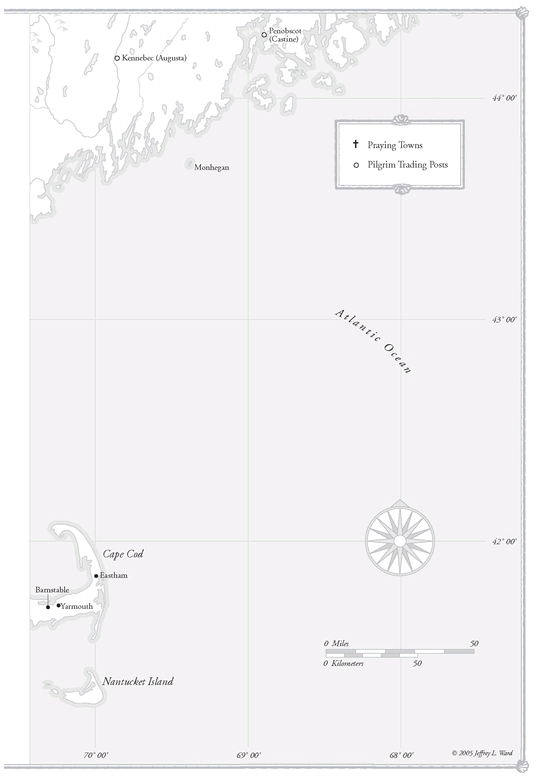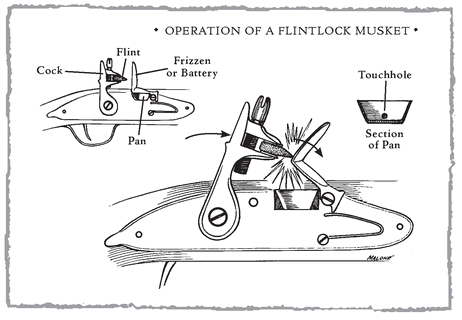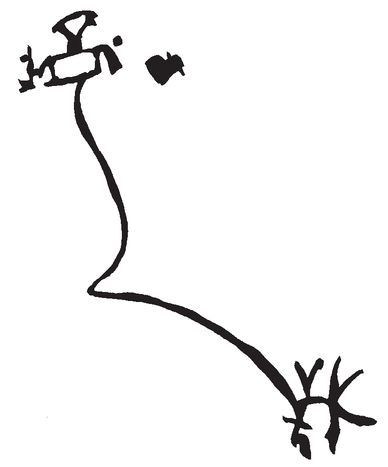Read The Mayflower and the Pilgrims' New World* Online
Authors: Nathaniel Philbrick
Tags: #Retail, #Ages 10+
The Mayflower and the Pilgrims' New World* (25 page)

BOOK: The Mayflower and the Pilgrims' New World*
3.98Mb size Format: txt, pdf, ePub
ads

A deep sadness began to overtake Bradford as he came to realize that Plymouth had failed to live up to her original spiritual mission.
Late in life, he looked back on the manuscript pages of his history of the colony. Beside a copy of a letter written by Pastor Robinson and Elder Brewster back in 1617, in which they referred to their congregation's “most strict and sacred bond,” Bradford wrote, “I have been happy in my first times, to see, and with much comfort to enjoy, the blessed fruits of this sweet communion, but it is now a part of my misery in old age, to find and feel the decay, and ... with grief and sorrow of heart to lament and bewail the same.”
No one knew what the future held, but Bradford had his suspicions. If New England continued its “degenerate” ways, God would surely have his vengeance. In Bradford's view, the seeds for this had been sown more than thirty years before, when Thomas Morton of Merrymount had begun selling guns to the Indians. Almost immediately, the Natives had become better huntsmen than the English “by reason of their swiftness of foot and nimbleness of body, being also quick-sighted and by continual exercise well knowing the haunts of all sorts of game.” They were also quick to learn how to use a musket and were soon able to perform their own repairs and make their own lead bullets.
The English were slow to give up their old and cumbersome matchlock muskets for the newer flintlocks, which came into use around 1630 and didn't require a burning wick (or “match”) to shoot. The Indians, on the other hand, knew from the start that they wanted only flintlocks. “[T]hey became mad (as it were) after them,” Bradford wrote, “and would not stick to give any price they could attain to for them; accounting their bows and arrows but baubles in comparison of them.” suddenly the English were no longer the technological superiors of the Native Americans, and when they ran into “the Indians in the woods armed with guns in this sort, it was a terror unto them.”

Over time, however, the English became accustomed to the sight of an Indian with a gun. Indians armed with flintlocks brought in more game and furs to English trading posts. And besides, if the Indians did not get their weapons from the English, they could easily buy them from the French and the Dutch. selling guns and ammunition was a highly profitable business, and Plymouth eventually came to approve the sales.
From Governor Bradford's perspective, the arming of the Indians showed that New England was headed for a fall. And it was the gun-toting Indians who would be “the rod” with which the Lord punished his people:
For these fierce natives, they are now so fill'd
With guns and muskets, and in them so skill'd
As that they may keep the English in awe,
And when they please, give unto them the law.
With guns and muskets, and in them so skill'd
As that they may keep the English in awe,
And when they please, give unto them the law.
In the winter of 1657, Bradford began to feel unwell. His health continued to decline until early May, when a sudden change came upon him. On the morning of May 8, “[T]he God of heaven so filled his mind with ineffable consolations,” Puritan historian Cotton Mather later wrote, “that he seemed little short of Paul, rapt up unto the unutterable entertainments of Paradise.” Here at long last was proof that the Lord had picked him to go to heaven. That morning he told those gathered around his sickbed that “the good spirit of God had given him a pledge of happiness in another world, and the first-fruits of his eternal glory.” He died the next day, “lamented by all the colonies of New England, as a common blessing and father to them all.”

â
A chair once owned by William Bradford.
A chair once owned by William Bradford.
Â
âââ In the forty years since the voyage of the
Mayflower,
the Native Americans had experienced huge changes, but they had continued to draw strength from traditional ways. The Pokanokets still hunted much as their fathers had done, but instead of bows and arrows, they now used the latest flintlock muskets. Inside their wigwams made of reed mats and tree bark were English chests in which they kept bracelets, rings, and strings of wampum beads. Attached to their buckskin breeches were brass bells that tinkled as they walked.
Mayflower,
the Native Americans had experienced huge changes, but they had continued to draw strength from traditional ways. The Pokanokets still hunted much as their fathers had done, but instead of bows and arrows, they now used the latest flintlock muskets. Inside their wigwams made of reed mats and tree bark were English chests in which they kept bracelets, rings, and strings of wampum beads. Attached to their buckskin breeches were brass bells that tinkled as they walked.
Given the spirituality of the Native Americans, it was perhaps inevitable that many of them also showed an interest in the Englishmen's religion. The Pilgrims had done little to convert the Indians to Christianity, but for the Puritans of Massachusetts Bay, it was a priority from the start. The colony's seal, created even before their arrival in the New World, showed a Native American saying, “Come over and help us.”
The Puritans believed a Christian must be able to read God's word in the Bible, and early on, efforts were made to teach the Indians how to read and write. A handful of Native Americans even attended the newly founded Harvard College. In the 1650s, the missionary John Eliot translated the entire Old and New Testaments into a phonetic version of the Massachusetts language, titled
Mamusse Wanneetupanatamwe Up-Biblum God.
Mamusse Wanneetupanatamwe Up-Biblum God.
Eliot created a series of Native communities known as Praying Towns. In addition to teaching the “Praying Indians” about Christianity, Eliot hoped to turn them from their traditional ways. But as was true with their use of flintlocks and jewelry, the Indians never wholly abandoned their former identities. Instead of replacing the old ways, Christianity became, for many Indians, the way for Native culture to endure.

â
Painting of missionary John Eliot, circa 1660.
Painting of missionary John Eliot, circa 1660.
For sachems in the seventeenth century, however, Christianity threatened their power. As increasing numbers of Indians turned to God, especially on Martha's Vineyard and Cape Cod, there were fewer left to supply Massasoit with the steady stream of tribute on which he had traditionally depended.
Â
âââ When it came to borrowing from the English, the Indians had demonstrated tremendous creativity and enthusiasm. The English were much more reluctant to borrow from the Indians, yet they did adopt some Native ways, particularly when it came to food. Ever since the Pilgrims stumbled across the buried corn on Cape Cod, maize had been an essential part of every New Englander's diet. It has been estimated that the Indians ate between 280 and 340 pounds of corn per person per year, and the English were not far behind. Hominy and johnnycakes, which became staples of early American diets, are adaptations of Native recipes. Over the years, the English pottage that Massasoit had craved on his sickbed had become more like the Indians' own succotash: a soupy mishmash of corn, beans, and whatever fish and meat were available. When it came to harvesting corn, the English adopted the Native husking bee celebration, a communal tradition in which a young man who came across a red ear of corn was allowed to demand a kiss from the girl of his choice.
When the Pilgrims had first settled at Plymouth, there had been forty miles between them and Massasoit's village at sowams. By 1655, there were just a few miles between the Pokanokets' headquarters and the closest English homes at Wannamoisett. An intimacy existed between the English and Indians that would have been almost unimaginable to later generations of Americans. The English hired their Indian neighbors as farmhands; they traded with them for fish and game. Inevitably, a mixture of English-Indian languages developed, and it became second nature for an Englishman to greet a Native acquaintance as
netop,
or friend.
netop,
or friend.
still, intermarriage between the two races was virtually nonexistent, and without children to provide them with a genetic and cultural common ground, the Indians and English would always have difficulty understanding each other's point of view. But while relations between the Indians and English were by no means perfect throughout the midpoint of the seventeenth century, the leaders on both sides worked hard to settle their differences. As they all understood, it was the only way to avoid a war.

â
Massasoit's pictogram from a 1657 land deed.
Massasoit's pictogram from a 1657 land deed.
âââ In the fall of 1657, a few months after the death of William Bradford, Massasoit, now approaching eighty years of age, signed his last Plymouth land deed. At the bottom of the parchment, he sketched an intricate pictogram. What looks like the upper portion of a man floats above what could be his legs with only a wavy line connecting the two. Whatever it actually shows, the pictogram gives a sense of distance and removal. With this deed, Massasoit disappears from the records of Plymouth Colony, only to reappear in the records of Massachusetts Bay as leader of the Quabaugs, a subgroup of the Nipmucks based more than fifty-five miles northwest of Pokanoket.
For years, the Pokanokets had maintained a close relationship with the Quabaugs, who lived with other subgroups of the Nipmucks between the Connecticut River to the west and the English settlements outside Boston to the east. As early as 1637, Massasoit came before officials in Boston as leader of the Quabaugs, and some historians think that twenty years later, in 1657, he moved to live among them. The move not only distanced the old sachem from Plymouth, it gave his eldest son, Wamsutta, who was nearly forty years old, a chance to establish himself as the Pokanokets' new leader.

BOOK: The Mayflower and the Pilgrims' New World*
3.98Mb size Format: txt, pdf, ePub
ads
Other books
Shaman's Blood by Anne C. Petty
Charbonneau by Win Blevins
Manacled in Monaco by Jianne Carlo
Catherine's Letters by Aubourg, Jean-Philippe
Draculas by J A Konrath, Blake Crouch, Kilborn, Jack, F. Paul Wilson, Jeff Strand
United (The Guardians Book 2) by Jessica Roe
The Great Train Robbery by Andrew Cook
Chasing Sunsets by Eva Marie Everson
Blown by Chuck Barrett
